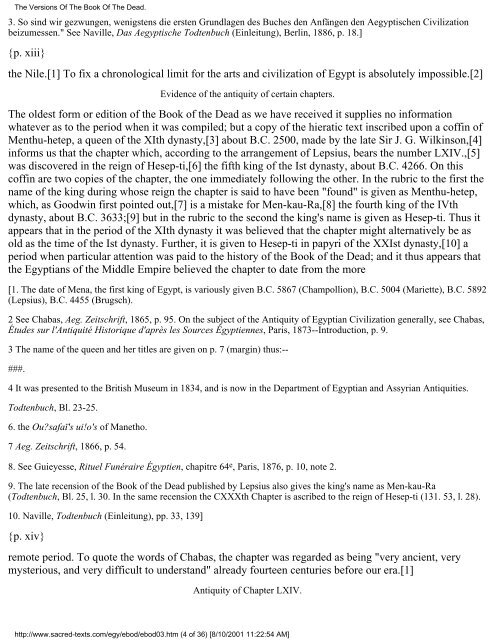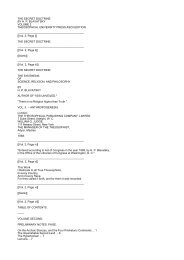Create successful ePaper yourself
Turn your PDF publications into a flip-book with our unique Google optimized e-Paper software.
The Versions Of The <strong>Book</strong> Of The <strong>Dead</strong>.<br />
3. So sind wir gezwungen, wenigstens die ersten Grundlagen des Buches den Anfängen den Aegyptischen Civilization<br />
beizumessen." See Naville, Das Aegyptische Todtenbuch (Einleitung), Berlin, 1886, p. 18.]<br />
{p. xiii}<br />
<strong>the</strong> Nile.[1] To fix a chronological limit for <strong>the</strong> arts and civilization <strong>of</strong> Egypt is absolutely impossible.[2]<br />
Evidence <strong>of</strong> <strong>the</strong> antiquity <strong>of</strong> certain chapters.<br />
The oldest form or edition <strong>of</strong> <strong>the</strong> <strong>Book</strong> <strong>of</strong> <strong>the</strong> <strong>Dead</strong> as we have received it supplies no information<br />
whatever as to <strong>the</strong> period when it was compiled; but a copy <strong>of</strong> <strong>the</strong> hieratic text inscribed upon a c<strong>of</strong>fin <strong>of</strong><br />
Menthu-hetep, a queen <strong>of</strong> <strong>the</strong> XIth dynasty,[3] about B.C. 2500, made by <strong>the</strong> late Sir J. G. Wilkinson,[4]<br />
informs us that <strong>the</strong> chapter which, according to <strong>the</strong> arrangement <strong>of</strong> Lepsius, bears <strong>the</strong> number LXIV.,[5]<br />
was discovered in <strong>the</strong> reign <strong>of</strong> Hesep-ti,[6] <strong>the</strong> fifth king <strong>of</strong> <strong>the</strong> Ist dynasty, about B.C. 4266. On this<br />
c<strong>of</strong>fin are two copies <strong>of</strong> <strong>the</strong> chapter, <strong>the</strong> one immediately following <strong>the</strong> o<strong>the</strong>r. In <strong>the</strong> rubric to <strong>the</strong> first <strong>the</strong><br />
name <strong>of</strong> <strong>the</strong> king during whose reign <strong>the</strong> chapter is said to have been "found" is given as Menthu-hetep,<br />
which, as Goodwin first pointed out,[7] is a mistake for Men-kau-Ra,[8] <strong>the</strong> fourth king <strong>of</strong> <strong>the</strong> IVth<br />
dynasty, about B.C. 3633;[9] but in <strong>the</strong> rubric to <strong>the</strong> second <strong>the</strong> king's name is given as Hesep-ti. Thus it<br />
appears that in <strong>the</strong> period <strong>of</strong> <strong>the</strong> XIth dynasty it was believed that <strong>the</strong> chapter might alternatively be as<br />
old as <strong>the</strong> time <strong>of</strong> <strong>the</strong> Ist dynasty. Fur<strong>the</strong>r, it is given to Hesep-ti in papyri <strong>of</strong> <strong>the</strong> XXIst dynasty,[10] a<br />
period when particular attention was paid to <strong>the</strong> history <strong>of</strong> <strong>the</strong> <strong>Book</strong> <strong>of</strong> <strong>the</strong> <strong>Dead</strong>; and it thus appears that<br />
<strong>the</strong> Egyptians <strong>of</strong> <strong>the</strong> Middle Empire believed <strong>the</strong> chapter to date from <strong>the</strong> more<br />
[1. The date <strong>of</strong> Mena, <strong>the</strong> first king <strong>of</strong> Egypt, is variously given B.C. 5867 (Champollion), B.C. 5004 (Mariette), B.C. 5892<br />
(Lepsius), B.C. 4455 (Brugsch).<br />
2 See Chabas, Aeg. Zeitschrift, 1865, p. 95. On <strong>the</strong> subject <strong>of</strong> <strong>the</strong> Antiquity <strong>of</strong> Egyptian Civilization generally, see Chabas,<br />
Études sur l'Antiquité Historique d'après les Sources Égyptiennes, Paris, 1873--Introduction, p. 9.<br />
3 The name <strong>of</strong> <strong>the</strong> queen and her titles are given on p. 7 (margin) thus:--<br />
###.<br />
4 It was presented to <strong>the</strong> British Museum in 1834, and is now in <strong>the</strong> Department <strong>of</strong> Egyptian and Assyrian Antiquities.<br />
Todtenbuch, Bl. 23-25.<br />
6. <strong>the</strong> Ou?safaï's ui!o's <strong>of</strong> Manetho.<br />
7 Aeg. Zeitschrift, 1866, p. 54.<br />
8. See Guieyesse, Rituel Funéraire Égyptien, chapitre 64 e , Paris, 1876, p. 10, note 2.<br />
9. The late recension <strong>of</strong> <strong>the</strong> <strong>Book</strong> <strong>of</strong> <strong>the</strong> <strong>Dead</strong> published by Lepsius also gives <strong>the</strong> king's name as Men-kau-Ra<br />
(Todtenbuch, Bl. 25, l. 30. In <strong>the</strong> same recension <strong>the</strong> CXXXth Chapter is ascribed to <strong>the</strong> reign <strong>of</strong> Hesep-ti (131. 53, l. 28).<br />
10. Naville, Todtenbuch (Einleitung), pp. 33, 139]<br />
{p. xiv}<br />
remote period. To quote <strong>the</strong> words <strong>of</strong> Chabas, <strong>the</strong> chapter was regarded as being "very ancient, very<br />
mysterious, and very difficult to understand" already fourteen centuries before our era.[1]<br />
Antiquity <strong>of</strong> Chapter LXIV.<br />
http://www.sacred-texts.com/egy/ebod/ebod03.htm (4 <strong>of</strong> 36) [8/10/2001 11:22:54 AM]

















